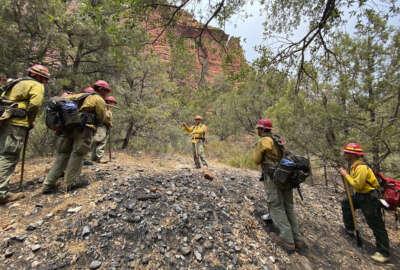Wildland firefighters at the Forest Service work beyond their job duties. Their union says that’s a big problem
NFFE says skipped-over job duties that wildland firefighters perform for the Forest Service could mean they’re missing out on thousands of dollars a year.
The Forest Service is readying plans to implement a new occupational series for federal wildland firefighters, but as the agency makes its way through the details, the National Federation of Federal Employees is raising concerns about accuracy of the updated job descriptions.
In a letter addressed to Agriculture Department and Forest Service leaders last week, NFFE, a union representing wildland firefighters, said the position descriptions the agency intends to use in the new occupational series remain “flawed,” and not entirely reflective of the work that wildland firefighters actually do. NFFE officials wrote that wildland firefighters have faced “prolonged abuse” of doing higher graded work without getting paid for it, adding that they’re concerned those practices will continue under the updated position descriptions the Forest Service is planning to put into effect.
“The agency has for far too long taken advantage of employees performing above their respective position description,” NFFE wrote in the Aug. 27 letter. “Sometimes by choice, other times persuaded as something needed to meet the agency’s mission under the pretense of ‘other duties as assigned.’”
Due to requirements from the Bipartisan Infrastructure Law, the Forest Service has already implemented new job descriptions and classifications for its non-bargaining unit wildland firefighters, and employees in those positions have transitioned into a new occupational series. The new descriptions for positions that are considered part of the NFFE bargaining unit are expected to commence in the coming months, according to a Forest Service spokesperson, although the agency has not yet set a specific date.
“We are committed to aligning the series with the best interests of our employees and the standards required by law,” the spokesperson wrote in an email to Federal News Network. “As it was intended to do, the new series identifies, defines and provides for wildland firefighters’ unique duties and responsibilities.”
An occupational series, according to OPM, defines the requirements and skills that employees should have to qualify for a federal position. Any occupational series could have dozens or even hundreds of specific job descriptions contained within it.
For years, NFFE has maintained that the increasing heat, intensity and length of wildfires has made wildland firefighters’ responsibilities much higher than what’s written in their job descriptions. Some common responsibilities for wildland firefighters, union officials said, are still missing from the Forest Service’s newly planned GS-0456 Wildland Fire Management series.
The union is urging the agency to specifically include, for example, emergency medical duties as part of the occupational series — since Emergency Medical Technician (EMT) duties often fall on the shoulders of wildland firefighters. There should also be consideration for other responsibilities, such as supervisory and crew boss duties, which NFFE said wildland firefighters regularly take on without additional pay.
“Some of them work heavy equipment, some of them are on engines, some of them are in airplanes, some of them are logistics people that don’t see flame, but they’re still in areas where there’s heavy smoke and contaminants,” Steve Lenkart, executive director of NFFE, said in an interview with Federal News Network. “We were disappointed when USDA seemed like they just couldn’t wrap their head around doing a deep dive and really throwing their arms around the entire project.”
The Forest Service spokesperson said the agency is taking NFFE’s concerns seriously.
“We engaged in an unprecedented level of collaboration with NFFE and disagree with their characterization of our work together,” the spokesperson wrote.
Pay differences for wildland firefighters
The difference in job descriptions versus actual work can impact how much money ends up in firefighters’ pockets, NFFE said. For example, while Forest Service wildland firefighters are typically graded as GS-3 through GS-6, employees who perform the duties of an EMT, according to OPM’s classifications, should be classified as GS-7.
NFFE said many wildland firefighters will perform EMT duties, but because they’re not classified as GS-7, their pay is below what it should be based on their on-the-job responsibilities. As an example, a GS-4 wildland firefighter working in Los Angeles, California, who performs EMT duties, could make between about $16,000 to $21,000 less per year than a GS-7 employee.
Lenkart said the outdated position descriptions also make it more difficult for wildland firefighters to move up the career ladder.
“It’s a big responsibility to be the medical person on a crew, but you’re not getting paid more for it. People are just doing it out of the goodness of their hearts, and they’re often having to pay for that stuff out of pocket to get certifications, to get recertified, to take trainings,” Lenkart said. “If you are going to take on that additional education and those additional responsibilities, you should be supported financially to do it, and then also paid for it when you’re doing the job.”
The Forest Service expects to implement the new occupational series for wildland firefighters in the bargaining unit in the coming months, although the agency does not have a specific timeframe for when it will begin advertising the updated positions. The Forest Service spokesperson said the process to finalize the occupational series is still underway.
“We may not be able to agree on all aspects, but we know our employees expect us to implement this new job series as soon as possible while working through any differences in negotiations,” the spokesperson said. “We remain committed to working with NFFE as we implement this first of its kind federal wildland firefighter occupational series.”
Once the Forest Service implements the new occupational series, all federal wildland firefighters have the option of either moving into the new series or sticking with their current position description.
Why the Forest Service is updating the series
The Forest Service’s major update to the wildland firefighter occupational series stems from the 2021 Infrastructure Investment and Jobs Act, commonly known as the Bipartisan Infrastructure Law. Within six months of the legislation’s enactment, USDA and the Interior Department — the two main federal employers of wildland firefighters — were required to update the General Schedule occupational series for the frontline workforce, which has faced growing challenges in the last several years.
Interior updated its occupational series for the GS-0456 Wildland Fire Management series in June 2022. But at the Forest Service, the picture is more complicated. When the infrastructure law passed, there were more than 400 different position descriptions for Forest Service workers classified as part of the series. The agency was tasked with combing through the hundreds of descriptions — some of which dated back to the mid-20th century — to determine which were still relevant, and which needed to be removed or updated.
Although the agency is aiming to keep position descriptions consistent with those at Interior, the Forest Service spokesperson said slight differences may arise “due to the specific needs and operational structures of each agency.”
“The Forest Service is making the same changes as [Interior] when it comes to position grades that are changing in the new series,” the spokesperson wrote. “Overall, efforts are made to ensure that job descriptions and occupational series are as aligned as possible to maintain standards across federal wildland firefighting positions.”
During the nearly three years since the infrastructure law passed, NFFE said it has been pushing agency leadership to involve federal wildland firefighters directly in making changes to the job descriptions, to help avoid discrepancies.
“This is looking at our members, but we’re also looking after the country. Because if we lose any more firefighters, we’re not going to be able to face these big fires, which are getting bigger and hotter every year,” NFFE’s Lenkart said. “All the planning and all the good intentions mean nothing if you don’t have the people there who are trained, qualified and willing to do the work.”
Copyright © 2024 Federal News Network. All rights reserved. This website is not intended for users located within the European Economic Area.
Drew Friedman is a workforce, pay and benefits reporter for Federal News Network.
Follow @dfriedmanWFED






